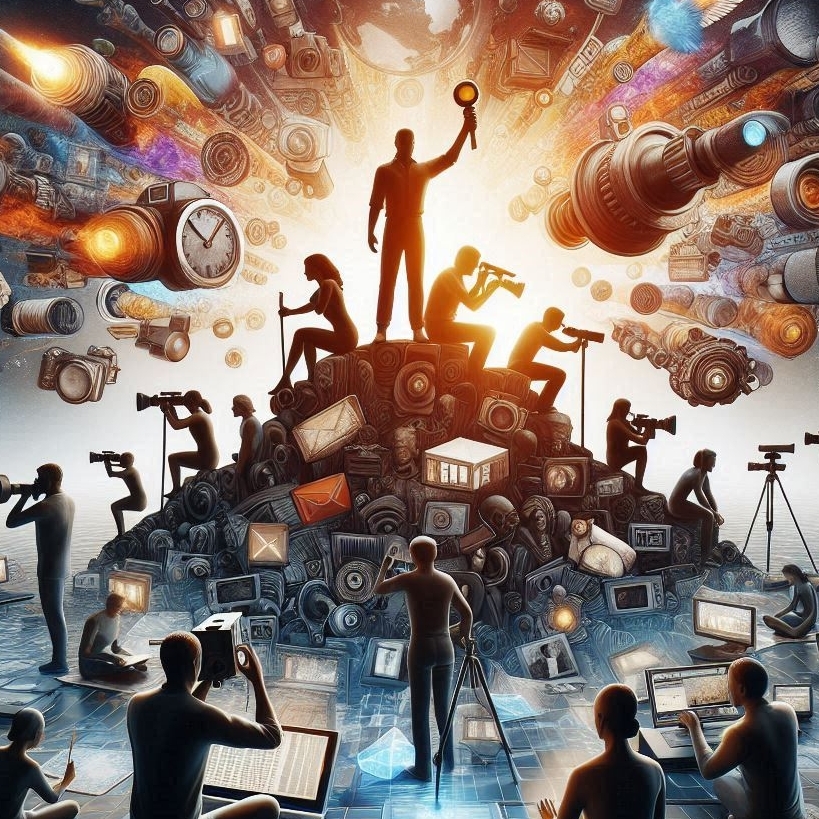Histroy and Facts
-
PBID: 0099001900000005
-
179 people like this
-
55 Posts
-
16 Photos
-
0 Videos
-
Reviews
-
BMA
Recent Updates
-
"Facts Don’t Shout - But They Matter the Most"Truth is not loud. But it’s powerful. In a world full of headlines, hashtags, and hot takes what should we really trust?Is it the voice that screams the loudest? Or the voice that dares to speak the truth, even when it’s inconvenient? Every day, we are flooded with information. But not everything we hear, read, or watch is a fact.Some are opinions.Some are...0 Comments 0 Shares 2K Views 0 ReviewsPlease log in to like, share and comment!
-
Jessica Lal Murder Case (1999): How Media Fought for JusticeIn April 1999 - Jessica Lal, a model, was shot dead at a party in Delhi after she refused to serve a drink to a man named Manu Sharma, the son of a powerful politician. Despite several eyewitnesses, the accused was acquitted in 2006 due to lack of evidence, weak investigation, and political influence. What Happened Next:The nation was shocked. People felt the justice system had failed. But the...0 Comments 0 Shares 2K Views 0 Reviews
-
Jessica Lal Murder Case (1999): How Media Fought for JusticeDelhi - In April 1999, Jessica Lal, a model, was shot dead at a party in Delhi after she refused to serve a drink to a man named Manu Sharma, the son of a powerful politician. Despite several eyewitnesses, the accused was acquitted in 2006 due to lack of evidence, weak investigation, and political influence. What Happened Next:The nation was shocked. People felt the justice system had failed....0 Comments 0 Shares 2K Views 0 Reviews
-
Digital Rights in JournalismDigital Rights in Journalism As journalism has moved online, digital rights have become critical. These are the rights that protect journalists, content creators, and citizens when they use digital platforms to share information. What Are Digital Rights for Journalists? Freedom of Speech OnlineJust like in newspapers, you have the right to express opinions, publish stories, and...0 Comments 0 Shares 3K Views 0 Reviews
-
Journalism Rights in India – A Fight for Truth, Then and NowJournalism in India didn’t begin in newsrooms. It began as a fight a voice raised against injustice. From the British era to the present day, journalism has been the backbone of democracy. But the right to speak freely, report facts, and question power didn’t come easily. A Brief History of Journalism Rights Pre-Independence EraEarly newspapers like Bengal Gazette (1780) and...0 Comments 0 Shares 4K Views 0 Reviews
-
1975 Emergency to Today: Are We Truly Free?"𝐖𝐡𝐞𝐧 𝐭𝐫𝐮𝐭𝐡 𝐢𝐬 𝐬𝐢𝐥𝐞𝐧𝐜𝐞𝐝, 𝐝𝐞𝐦𝐨𝐜𝐫𝐚𝐜𝐲 𝐰𝐡𝐢𝐬𝐩𝐞𝐫𝐬 𝐢𝐧 𝐟𝐞𝐚𝐫." 𝐉𝐮𝐧𝐞 𝟐𝟓, 𝟏𝟗𝟕𝟓 𝐨𝐧𝐞 𝐨𝐟 𝐭𝐡𝐞 𝐝𝐚𝐫𝐤𝐞𝐬𝐭 𝐧𝐢𝐠𝐡𝐭𝐬 𝐢𝐧 𝐈𝐧𝐝𝐢𝐚𝐧 𝐝𝐞𝐦𝐨𝐜𝐫𝐚𝐜𝐲. 𝐓𝐡𝐞𝐧 𝐏𝐫𝐢𝐦𝐞 𝐌𝐢𝐧𝐢𝐬𝐭𝐞𝐫 𝐈𝐧𝐝𝐢𝐫𝐚 𝐆𝐚𝐧𝐝𝐡𝐢 𝐝𝐞𝐜𝐥𝐚𝐫𝐞𝐝 𝐚 𝐧𝐚𝐭𝐢𝐨𝐧𝐚𝐥 𝐄𝐦𝐞𝐫𝐠𝐞𝐧𝐜𝐲, 𝐬𝐮𝐬𝐩𝐞𝐧𝐝𝐢𝐧𝐠 𝐜𝐢𝐯𝐢𝐥 𝐥𝐢𝐛𝐞𝐫𝐭𝐢𝐞𝐬, 𝐜𝐞𝐧𝐬𝐨𝐫𝐢𝐧𝐠 𝐭𝐡𝐞 𝐩𝐫𝐞𝐬𝐬, 𝐚𝐧𝐝 𝐚𝐫𝐫𝐞𝐬𝐭𝐢𝐧𝐠 𝐨𝐩𝐩𝐨𝐬𝐢𝐭𝐢𝐨𝐧 𝐯𝐨𝐢𝐜𝐞𝐬. 𝐅𝐨𝐫 𝟐𝟏 𝐥𝐨𝐧𝐠 𝐦𝐨𝐧𝐭𝐡𝐬, 𝐭𝐡𝐞 𝐈𝐧𝐝𝐢𝐚𝐧 𝐂𝐨𝐧𝐬𝐭𝐢𝐭𝐮𝐭𝐢𝐨𝐧’𝐬 𝐯𝐞𝐫𝐲 𝐬𝐩𝐢𝐫𝐢𝐭 𝐰𝐚𝐬 𝐩𝐮𝐭 𝐨𝐧 𝐡𝐨𝐥𝐝. 𝐖𝐡𝐚𝐭 𝐇𝐚𝐩𝐩𝐞𝐧𝐞𝐝 𝐢𝐧 𝟏𝟗𝟕𝟓? 𝐏𝐫𝐞𝐬𝐬 𝐂𝐞𝐧𝐬𝐨𝐫𝐬𝐡𝐢𝐩: 𝐍𝐞𝐰𝐬𝐩𝐚𝐩𝐞𝐫𝐬...0 Comments 0 Shares 2K Views 0 Reviews1

-
Do you Know? Where Does India Stand on the Global Press Freedom Map?Do you Know? Where Does India Stand on the Global Press Freedom Map?Explore our world ranking and what it means for journalism in India.India's Press Freedom Ranking Overview• 2025 Rank: 151st out of 180 countries• Previous Rank (2024): 159th• Top 3 Countries: Norway, Estonia, Netherlands• India's Neighbors:o Nepal: 90tho Maldives: 104tho Sri Lanka: 139tho Bangladesh:...0 Comments 0 Shares 6K Views 0 Reviews
-
Do you Know? Where Does India Stand on the Global Press Freedom Map?
Explore our world ranking and what it means for journalism in India.
India's Press Freedom Ranking Overview
• 2025 Rank: 151st out of 180 countries
• Previous Rank (2024): 159th
• Top 3 Countries: Norway, Estonia, Netherlands
• India's Neighbors:
o Nepal: 90th
o Maldives: 104th
o Sri Lanka: 139th
o Bangladesh: 149th
o Bhutan: 152nd
o Pakistan: 158th
o Myanmar: 169th
o Afghanistan: 175th
o China: 178th
Key Factors Affecting India's Ranking
evaluates countries based on five indicators: political context, legal framework, economic context, sociocultural context, and safety of journalists.
• Political Context: India's media has experienced an "unofficial state of emergency" since 2014, with
increasing alignment between major media houses and the ruling party.
• Legal Framework: The use of colonial-era laws, such as sedition and defamation, along with new
legislations like the 2023 Telecommunications Act, has granted the government extensive powers to
control media and suppress dissent.
• Economic Context: Media ownership is highly concentrated, with major conglomerates like Reliance
Industries and the Adani Group controlling significant portions of the media landscape, potentially
influencing editorial independence.
• Sociocultural Context: The media landscape lacks diversity, with managerial positions predominantly
held by upper-caste Hindu men, leading to underrepresentation of marginalized communities.
• Safety of Journalists: Journalists face threats, harassment, and violence, with at least 15 charged under
anti-terrorism laws and 36 detained since 2014.
Notable Incidents
• Harassment and Threats: Journalists like Harleen Kapoor and Arjun Menon have reported threats and
pressure to avoid sensitive topics, reflecting a climate of fear and suppression.
• Legal Actions: The arrest of journalist Siddique Kappan and the revocation of non-profit status for
independent outlets like The Reporters' Collective highlight the use of legal mechanisms to stifle
independent journalism.
📍 Do you Know? Where Does India Stand on the Global Press Freedom Map? Explore our world ranking and what it means for journalism in India. India's Press Freedom Ranking Overview • 2025 Rank: 151st out of 180 countries • Previous Rank (2024): 159th • Top 3 Countries: Norway, Estonia, Netherlands • India's Neighbors: o Nepal: 90th o Maldives: 104th o Sri Lanka: 139th o Bangladesh: 149th o Bhutan: 152nd o Pakistan: 158th o Myanmar: 169th o Afghanistan: 175th o China: 178th 📉 Key Factors Affecting India's Ranking evaluates countries based on five indicators: political context, legal framework, economic context, sociocultural context, and safety of journalists. • Political Context: India's media has experienced an "unofficial state of emergency" since 2014, with increasing alignment between major media houses and the ruling party. • Legal Framework: The use of colonial-era laws, such as sedition and defamation, along with new legislations like the 2023 Telecommunications Act, has granted the government extensive powers to control media and suppress dissent. • Economic Context: Media ownership is highly concentrated, with major conglomerates like Reliance Industries and the Adani Group controlling significant portions of the media landscape, potentially influencing editorial independence. • Sociocultural Context: The media landscape lacks diversity, with managerial positions predominantly held by upper-caste Hindu men, leading to underrepresentation of marginalized communities. • Safety of Journalists: Journalists face threats, harassment, and violence, with at least 15 charged under anti-terrorism laws and 36 detained since 2014. 📰 Notable Incidents • Harassment and Threats: Journalists like Harleen Kapoor and Arjun Menon have reported threats and pressure to avoid sensitive topics, reflecting a climate of fear and suppression. • Legal Actions: The arrest of journalist Siddique Kappan and the revocation of non-profit status for independent outlets like The Reporters' Collective highlight the use of legal mechanisms to stifle independent journalism.0 Comments 0 Shares 2K Views 0 Reviews -
"When NEWS Has a Price, the Truth Pays the Cost. But Journalism Was Never Meant to be for Sale."
#TruthNotForSale #StopPaidNews #BMAEdge#BMA#bharatmediaassociation#Media#Mediaprofessionals"When NEWS Has a Price, the Truth Pays the Cost. But Journalism Was Never Meant to be for Sale." #TruthNotForSale #StopPaidNews #BMAEdge#BMA#bharatmediaassociation#Media#Mediaprofessionals0 Comments 1 Shares 14K Views 0 Reviews 2
2
-
"In a Country Where Headlines are Shaped in Studios, the Real Stories Often Remain Unheard. Let's Step Beyond the Noise..."
Then Flow into The Text Overlay:
Studio: Loud Debates. No Solutions.
Ground: Water Crisis. Farmer Suicides. Caste Injustice.
But Who’s Covering the Real Stories?
We are. And so are Thousands of Rural Journalists.
Solution? Empower Local Reporting. BMA is Building that Bridge.
#StudioVsGround #RealJournalismMatters #BMAEdge"In a Country Where Headlines are Shaped in Studios, the Real Stories Often Remain Unheard. Let's Step Beyond the Noise..." Then Flow into The Text Overlay: 📺 Studio: Loud Debates. No Solutions. 🌾 Ground: Water Crisis. Farmer Suicides. Caste Injustice. 🎙️ But Who’s Covering the Real Stories? 💪 We are. And so are Thousands of Rural Journalists. 🛠️ Solution? Empower Local Reporting. BMA is Building that Bridge. #StudioVsGround #RealJournalismMatters #BMAEdge0 Comments 0 Shares 10K Views 0 Reviews 3
3
-
Ever Wondered Who Really Controls Your News?
While Breaking News Flashes Across Screens…
Deals are Made Behind Boardroom Doors.
Real Issues are Often Ignored.
But There’s Hope.
On The ground, Honest Eeporters Still Fight for the Truth.
Bharat Media Association Stands With Them — And With YOU.
Let’s Reclaim Journalism. Let’s Amplify Real Voices.
Watch, Share & Be Part of the Change.
#WhoControlsTheNews #BMAVoice #IndependentMedia #JournalismMatters #TruthOverTRPs #BharatAawaz #BMAEdge🧠 Ever Wondered Who Really Controls Your News? 📰 While Breaking News Flashes Across Screens… 💼 Deals are Made Behind Boardroom Doors. 🤐 Real Issues are Often Ignored. But There’s Hope. ✊ On The ground, Honest Eeporters Still Fight for the Truth. 🎙️ Bharat Media Association Stands With Them — And With YOU. Let’s Reclaim Journalism. Let’s Amplify Real Voices. 👉 Watch, Share & Be Part of the Change. #WhoControlsTheNews #BMAVoice #IndependentMedia #JournalismMatters #TruthOverTRPs #BharatAawaz #BMAEdge0 Comments 0 Shares 13K Views 0 Reviews -
The Forgotten Frontline: Rural Journalists Under Threat"
They Don’t Sit in Studios. They Walk Miles to Bring you the Truth.
From Tribal Villages in Gadchiroli to Small Towns in Vidarbha, Rural Reporters Risk Their Lives Daily to Expose Injustice. Yet, They Face Threats, FIRs, and Pressure From Local Powers.
It’s Time We Protect Those Who Protect Democracy.
Watch This Reel and Share if You Believe Local Voices Matter.
#RuralJournalism #BharatMediaAssociation #BMAEdge #PressFreedom #GrassrootsVoicesThe Forgotten Frontline: Rural Journalists Under Threat" They Don’t Sit in Studios. They Walk Miles to Bring you the Truth. From Tribal Villages in Gadchiroli to Small Towns in Vidarbha, Rural Reporters Risk Their Lives Daily to Expose Injustice. Yet, They Face Threats, FIRs, and Pressure From Local Powers. It’s Time We Protect Those Who Protect Democracy. Watch This Reel and Share if You Believe Local Voices Matter. #RuralJournalism #BharatMediaAssociation #BMAEdge #PressFreedom #GrassrootsVoices0 Comments 0 Shares 11K Views 0 Reviews -
A Single Fake Post Can Divide Communities and Destroy Lives.
Fake News Spreads Fast — Truth Needs Defenders. Be the One Who Verifies Before Sharing.
#BMA#bharatmediaprofessionals#Mediaprofessionals#Journalism#
❌ A Single Fake Post Can Divide Communities and Destroy Lives. Fake News Spreads Fast — Truth Needs Defenders. Be the One Who Verifies Before Sharing. #BMA#bharatmediaprofessionals#Mediaprofessionals#Journalism#0 Comments 0 Shares 7K Views 0 Reviews1
-
What Looks Like News… Might Actually be an ad.
Paid News is Fake News in Disguise. Know How to Spot it Before it Spreads.
#BMA#bharatmediaassociation, #BMAmebership#MediaprofessionalsWhat Looks Like News… Might Actually be an ad. Paid News is Fake News in Disguise. Know How to Spot it Before it Spreads. #BMA#bharatmediaassociation, #BMAmebership#Mediaprofessionals0 Comments 0 Shares 10K Views 0 Reviews1
-
Some Issues Vanish from Headlines.
Not Because They Don’t Matter — But Because They Threaten Power. This is Silent Censorship. Let’s Talk about
#BMA#bharatmediaassociation#Mediaprofessionals#Journalism#censorship🚫 Some Issues Vanish from Headlines. Not Because They Don’t Matter — But Because They Threaten Power. This is Silent Censorship. Let’s Talk about #BMA#bharatmediaassociation#Mediaprofessionals#Journalism#censorship0 Comments 0 Shares 8K Views 0 Reviews -
Social Media – New Age Politics
Likes. Shares. Hashtags.
Social Media is Shaping Elections — and your Opinion. But are You Being Informed, or Just Influenced?📱Social Media – New Age Politics Likes. Shares. Hashtags. Social Media is Shaping Elections — and your Opinion. But are You Being Informed, or Just Influenced?0 Comments 0 Shares 5K Views 0 Reviews -
Who Funds the Media?
Want to Know Why Some Issues are Never Reported?
Follow the Money. Ownership Shapes Coverage. Independent Media is the Need of the Hour.
#BMA#bharatmediaassociation#Funds#Mediaprofessional#mediaaspirants
💰 Who Funds the Media? Want to Know Why Some Issues are Never Reported? Follow the Money. Ownership Shapes Coverage. Independent Media is the Need of the Hour. #BMA#bharatmediaassociation#Funds#Mediaprofessional#mediaaspirants0 Comments 0 Shares 4K Views 0 Reviews -
Media Trials – Justice or Circus?
When Media Acts as Judge and Jury, Truth is the Victim.
Media Trials May Entertain, but They Often Destroy Lives. Think Twice Before Believing the Noise.
#BMA#bharatmediaassociation#Mediaprofesisonals#⚖️ Media Trials – Justice or Circus? When Media Acts as Judge and Jury, Truth is the Victim. Media Trials May Entertain, but They Often Destroy Lives. Think Twice Before Believing the Noise. #BMA#bharatmediaassociation#Mediaprofesisonals#0 Comments 0 Shares 3K Views 0 Reviews
More Stories






